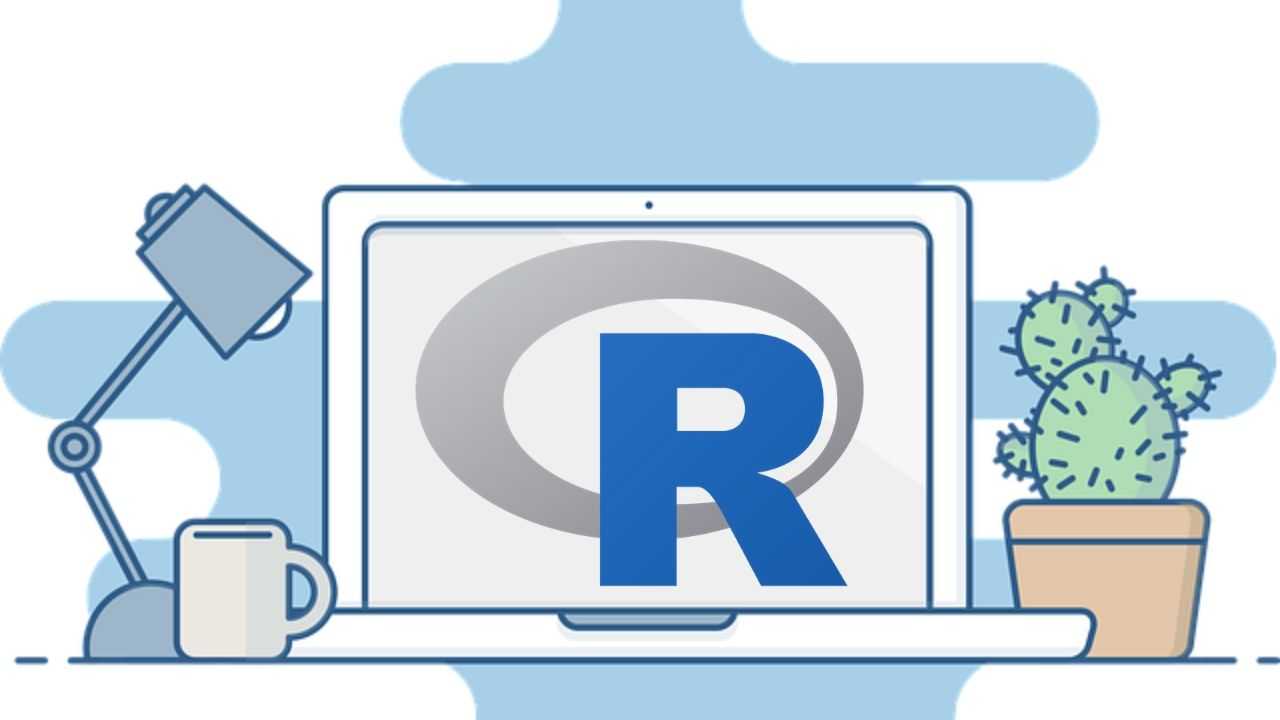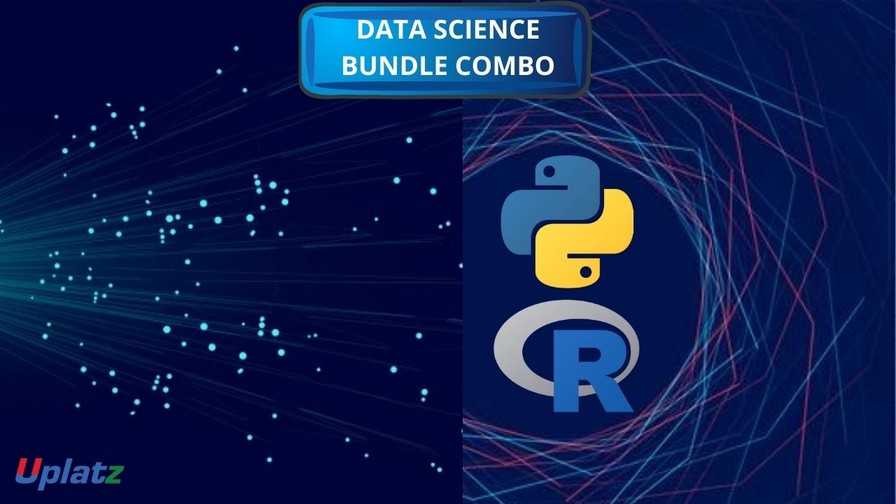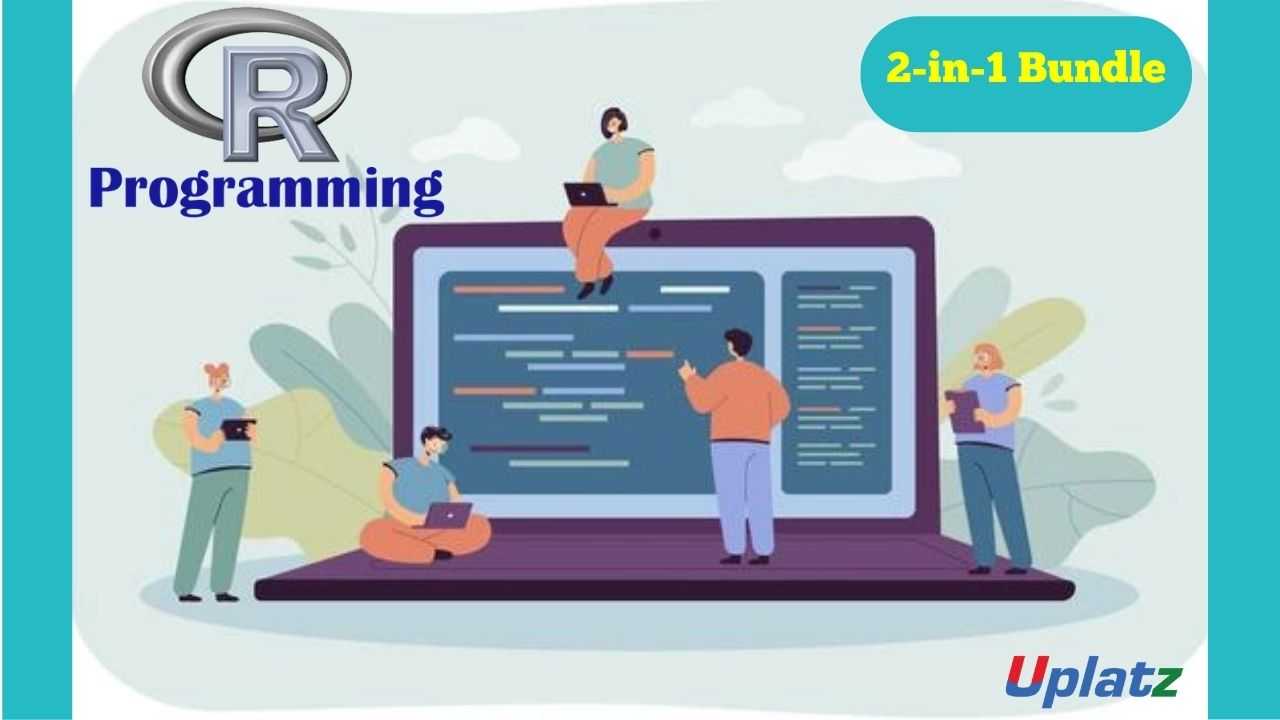R Programming
Basics of R programming - syntax, functions, loop, data frames, melting, casting, etc. Perform data visualization, data analytics, data science with RPreview R Programming course
Price Match Guarantee Full Lifetime Access Access on any Device Technical Support Secure Checkout Course Completion Certificate 90% Started a new career
BUY THIS COURSE (
90% Started a new career
BUY THIS COURSE (GBP 12 GBP 29 )-
 95% Got a pay increase and promotion
95% Got a pay increase and promotion
Students also bought -
-

- R Programming (basic to advanced)
- 20 Hours
- GBP 12
- 361 Learners
-

- Bundle Combo - Data Science (with Python and R)
- 70 Hours
- GBP 22
- 3110 Learners
-

- Bundle Multi (2-in-1) - R Programming
- 30 Hours
- GBP 22
- 839 Learners

R is a software programming language cum environment which is used to analyze statistical information and graphical representation. R allows us to do modular programming using functions. R is a statistical analysis, graphical representation, and reporting computer language and software environment. This course is for software programmers, statisticians, and data miners who want to learn how to create statistical software using the R programming language.
R is an interpreted computer programming language which was created by Ross Ihaka and Robert Gentleman at the University of Auckland, New Zealand." The R Development Core Team currently develops R. It is also a software environment used to analyze statistical information, graphical representation, reporting, and data modeling. R is the implementation of the S programming language, which is combined with lexical scoping semantics.
R not only allows us to do branching and looping but also allows to do modular programming using functions. R allows integration with the procedures written in the C, C++, .Net, Python, and FORTRAN languages to improve efficiency.
In the present era, R is one of the most important tool which is used by researchers, data analyst, statisticians, and marketers for retrieving, cleaning, analyzing, visualizing, and presenting data. R programmers play a critical role in helping organizations make data-driven decisions by analyzing, modeling, and visualizing complex data sets using statistical methods and programming skills.
This R Programming course by Uplatz covers practical issues in statistical computing which includes programming in R, reading data into R, accessing R packages, writing R functions, debugging, profiling R code, and organizing and commenting R code. Topics in statistical data analysis will provide working examples.
In Introduction to R, you will master the basics of this widely used open source language, including factors, lists, and data frames. With the knowledge gained in this course, you will be ready to undertake your first very own data analysis. Oracle estimated over 2 million R users worldwide in 2012, cementing R as a leading programming language in statistics and data science. Every year, the number of R users grows by about 40%, and an increasing number of organizations are using it in their day-to-day activities. Begin your journey to learn R with us today!
R programming language course will provide you with a sufficient grasp of virtually all of the language's principles, allowing you to progress to greater levels of competence. Because this course is for beginners, no prior knowledge of computer programming terminology is required. This introductory course will assist you in grasping the fundamentals of R programming and progressing to more advanced topics. This R training includes all topics of R such as introduction, features, installation, rstudio ide, variables, datatypes, operators, if statement, vector, data handing, graphics, statistical modelling, etc.
Course/Topic - R Programming - all lectures
-
In this lecture session we learn about basic introduction of R programming for beginners and also talk about basic functions of R programming for beginners.
-
In this tutorial we learn about how we install r programming in our software and also talk about the best way of installing R programming for beginners.
-
In this lecture session we learn about R's basic data structures including the vector, list, matrix, data frame, and factors. Some of these structures require that all members be of the same data type (e.g. vectors, matrices) while others permit multiple data types (e.g. lists, data frames). Objects may have attributes, such as name, dimension, and class.
-
In this lecture session we learn about A vector is the basic data structure in R, or we can say vectors are the most basic R data objects.
-
In this lecture session we learn about R is an ideal tool when it comes to data wrangling. It allows the usage of several preprocessed packages that makes data wrangling a lot more easier. This is one of the main reasons as to why R is preferred in the Data Science community.
-
In this lecture session we learn about R packages are a collection of R functions, compiled code and sample data. They are stored under a directory called "library" in the R environment. By default, R installs a set of packages during installation. More packages are added later, when they are needed for some specific purpose.
-
In this tutorial we learn about R is an open-source programming language that is widely used as a statistical software and data analysis tool.
-
In this lecture session we learn that R can be used as a powerful calculator by entering equations directly at the prompt in the command console. Simply type your arithmetic expression and press ENTER. R will evaluate the expressions and respond with the result.
-
In this tutorial we learn about Conditional statements are those statements where a hypothesis is followed by a conclusion. It is also known as an " If-then" statement.
-
In this tutorial we learn about In coding, you ask your computer to check conditions by writing conditional statements. Conditional statements are the way computers can make decisions.
-
In this lecture session we learn about It is a type of control statement that enables one to easily construct a loop that has to run statements or a set of statements multiple times. For loop is commonly used to iterate over items of a sequence.
-
In this lecture session we learn about Repeat loop, unlike other loops, doesn't use a condition to exit the loop instead it looks for a break statement that executes if a condition within the loop body results to be true.
-
In this lecture session we learn that Sum of n natural numbers can be defined as a form of arithmetic progression where the sum of n terms are arranged in a sequence with the first term being.
-
In this lecture session we learn about The formula to find the sum of n terms in AP is Sn = n/2 (2a+(n−1)d), in which a = first term, n = number of terms, and d = common difference between consecutive terms.
-
In this tutorial we learn about A switch statement that allows a variable to be tested for equality against a list of values. Each value is called a case, and the variable being switched on is checked for each case.
-
In this lecture session we learn about Data preprocessing, a component of data preparation, describing any type of processing performed on raw data to prepare it for another data processing procedure.
-
In this tutorial we learn about Data preprocessing is essential before its actual use. Data preprocessing is the concept of changing the raw data into a clean data set. The dataset is preprocessed in order to check missing values, noisy data, and other inconsistencies before executing it to the algorithm.
-
In this lecture session we learn about Factor in R is a variable used to categorize and store the data, having a limited number of different values. It stores the data as a vector of integer values. Factor in R is also known as a categorical variable that stores both string and integer data values as levels.
-
In this tutorial we learn about A data frame is a table or a two-dimensional array-like structure in which each column contains values of one variable and each row contains one set of values from each column.
-
In this tutorial we learn about In R we use merge() function to merge two dataframes in R. This function is present inside the join() function of the dplyr package.
-
In this lecture session we learn about The R merge function allows merging two data frames by common columns or by row names. This function allows you to perform different database (SQL) joins, like left join, inner join, right join or full join, among others.
-
In this tutorial we learn about The two data frames must have the same variables, but they do not have to be in the same order.
-
In this lecture session we learn about merge is a generic function whose principal method is for data frames: the default method coerces its arguments to data frames and calls the "data. frame" method. By default the data frames are merged on the columns with names they both have, but separate specifications of the columns can be given by.
-
In this lecture session we learn about The functions which are already created or defined in the programming framework are known as a built-in function. R has a rich set of functions that can be used to perform almost every task for the user.
-
In this lecture session we learn about Melting and Casting are one of the interesting aspects in R programming to change the shape of the data and further, getting the desired shape.
• Master the use of the R and RStudio interactive environment
• Expand R by installing R packages
• Explore and understand how to use the R documentation
• Read Structured Data into R from various sources
• Understand the different data types in R
• Understand the different data structures in R
• Understand how to create and manipulate dates in R
• Use the tidyverse collection of packages to manipulate dataframes
• Write user-defined R functions
• Use control statements
• Write Loop constructs in R
• Use the apply family of functions to iterate functions across data
• Expand iteration and programming through the Purrr package
• Reshape data from long to wide and back to support different analyses
• Perform merge operations with R
• Understand split-apply-combine (group-wise operations) in R
• Identify and deal with missing data
• Manipulate strings in R
• Understand basic regular expressions in R
The R Programming for BeginnersCertification ensures you know planning, production and measurement techniques needed to stand out from the competition.
R is a programming language widely used by data scientists and major corporations like Google, Airbnb, Facebook etc. for data analysis. This is a complete course on R for beginners and covers basics to advance topics like machine learning algorithm, linear regression, time series, statistical inference etc.
R is a great language for programming beginners to learn, and you don't need any prior experience with code to pick it up. Nowadays, R is easier to learn than ever thanks to the tidyverse collection of packages.
R offers a wide variety of statistics-related libraries and provides a favorable environment for statistical computing and design. In addition, the R programming language gets used by many quantitative analysts as a programming tool since it's useful for data importing and cleaning.
Overall, Python's easy-to-read syntax gives it a smoother learning curve. R tends to have a steeper learning curve at the beginning, but once you understand how to use its features, it gets significantly easier. Tip: Once you've learned one programming language, it's typically easier to learn another one.
Uplatz online training guarantees the participants to successfully go through the R Programming for Beginners Certification provided by Uplatz. Uplatz provides appropriate teaching and expertise training to equip the participants for implementing the learnt concepts in an organization.
Course Completion Certificate will be awarded by Uplatz upon successful completion of the R Programming for Beginners online course.
The R Programmer draws an average salary of $125,000 per year depending on their knowledge and hands-on experience.
R programmers are most in-demand, especially in emerging startups. Some of the positions that are available for the R programmers are as follows: Data Scientist. Business Analyst.
Various big tech companies like Facebook, Google, Uber, etcare using the R language for their businesses, and considering the rapidly increasing demand for data science and machine learning trends, learning the R programming language is surely worthwhile for your future career endeavors.
Sr. Data Scientist.
R - Shiny Programmer.
Data Analytics
1) Explain what is R?
R is data analysis software which is used by analysts, quants, statisticians, data scientists and others.
2) List out some of the function that R provides?
The function that R provides are
- Mean
- Median
- Distribution
- Covariance
- Regression
- Non-linear
- Mixed Effects
- GLM
- GAM. etc.
3) Explain how you can start the R commander GUI?
Typing the command, ("Rcmdr") into the R console starts the R commander GUI.
4) In R how you can import Data?
You use R commander to import Data in R, and there are three ways through which you can enter data into it
- You can enter data directly via Data à New Data Set
- Import data from a plain text (ASCII) or other files (SPSS, Minitab, etc.)
- Read a data set either by typing the name of the data set or selecting the data set in the dialog box
5) Mention what does not ‘R’ language do?
- Though R programming can easily connects to DBMS is not a database
- R does not consist of any graphical user interface
- Though it connects to Excel/Microsoft Office easily, R language does not provide any spreadsheet view of data
6) Explain how R commands are written?
In R, anywhere in the program you have to preface the line of code with a #sign, for example
- # subtraction
- # division
- # note order of operations exists
7) How can you save your data in R?
To save data in R, there are many ways, but the easiest way of doing this is
Go to Data > Active Data Set > Export Active Data Set and a dialogue box will appear, when you click ok the dialogue box let you save your data in the usual way.
8) Mention how you can produce co-relations and covariances?
You can produce co-relations by the cor () function to produce co-relations and cov () function to produce covariances.
9) Explain what is t-tests in R?
In R, the t.test () function produces a variety of t-tests. T-test is the most common test in statistics and used to determine whether the means of two groups are equal to each other.
10) Explain what is With () and By () function in R is used for?
- With() function is similar to DATA in SAS, it apply an expression to a dataset.
- BY() function applies a function to each level of factors. It is similar to BY processing in SAS.
11) What are the data structures in R that is used to perform statistical analyses and create graphs?
R has data structures like:
- Vectors
- Matrices
- Arrays
- Data frames
12) Explain general format of Matrices in R?
General format is
Mymatrix< - matrix (vector, nrow=r , ncol=c , byrow=FALSE,
dimnames = list ( char_vector_ rowname, char_vector_colnames))
13) In R how missing values are represented ?
In R missing values are represented by NA (Not Available), why impossible values are represented by the symbol NaN (not a number).
14) Explain what is transpose?
For re-shaping data before, analysis R provides various method and transpose are the simplest method of reshaping a dataset. To transpose a matrix or a data frame t () function is used.
15) Explain how data is aggregated in R?
By collapsing data in R by using one or more BY variables, it becomes easy. When using the aggregate() function the BY variable should be in the list.
16) What is the function used for adding datasets in R?
rbind function can be used to join two data frames (datasets). The two data frames must have the same variables, but they do not have to be in the same order.
17) What is the use of subset() function and sample() function in R?
In R, subset() functions help you to select variables and observations while through sample() function you can choose a random sample of size n from a dataset.
18) Explain how you can create a table in R without external file?
Use the code
myTable = data.frame()
edit(myTable)
This code will open an excel like spreadsheet where you can easily enter your data.









